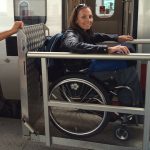All European cities may look similar with the splendid architecture and fine cuisine, but they sure differ in their transport systems. Europe wheelchair travel may be an uneven experience, so plan ahead an know what to expect. Accessibility laws in some form exist in most European countries, but their implementation differs significantly. So, it would be wise to check specific transportation rules and conditions before embarking on your trip. When planning a trip to Switzerland, one can be rather optimistic.
Switzerland Public Transportation
By 2023 the Swiss government is planning to have all the transport infrastructure adjusted for people with disabilities to be able to travel independently. But already before that deadline most transportation options can accommodate to your needs. Public transport in Switzerland includes very advanced railway system covering the whole country including the most picturesque mountain and lakes regions. Bus lines connecting big and small cities, and even boats can be an option for your journey.
You’d just need some preparatory information digging for specific routes and timelines you might require. For starters, get an overview of accessible travel in Switzerland. But research for up-to-date information should not be too tiresome as Swiss tourist services providers as well as authorities are impressively dedicated to make your life easier. Specific Information Office for barrier-free travel is operating for any inquiries, asking for assistance at transport, or ordering special guide.
Switzerland Rail Travel
In Switzerland you can travel pretty much anywhere by train, which is also the most spacious options for passengers in wheelchairs. Country has thousands of miles of railroads which are used by different railway operators, both state-owned and private.
No matter what route you need, you can always look for tickets on trustworthy tickets aggregators or on railway operators’ websites. There too usually you can find all the necessary information and data regarding accessibility and contacts for inquires and support. For example, SBB lines have dedicated space online guiding passengers with restricted mobility.
In most cases there are hydraulic lifts at train stations which serve as meeting points with support staff to provide you assistance with boarding the train. You can reserve such assistance in advance for free by contacting SBB call center.
Most regional and long-distance trains have two designates sets for passengers in wheelchairs, and some up to ten seats. Few night trains you can take for international routes have at least one compartment with a wheelchair-accessible couchette and a bed d for companion. Most trains have wheelchair-accessible toilets as well, but it is advisable to check their specific location and availability on your route in advance.
Swiss trains are well-maintained and renewed regularly, so passengers’ comfort is a priority. And if you wish to see the gorgeous cities and nature of Switzerland but you also need to work, you can benefit from free Wi-Fi on most trains. And some even have a business zone for concentrated work with outlets and enhanced reception for your mobile connection. So you can travel and keep doing your job remotely.
Switzerland Road Travel
Wherever train doesn’t take you, there goes the bus. In general, bus system is a bit behind the railway with accessibility adjustments, but you may not notice this gap. Most of the buses are low-floor models with easy access for a wheelchair. However, in smaller towns or villages there might be a chance of using a PostBus, which may have a lower floor or not. Even with lower access there might still be quite a gap to bridge upon entering. In some cases, the bus driver installs a small ramp and helps a passenger in a wheelchair to get on board.
Buses are often equipped with two places for wheelchairs with necessary fastenings. Please check the timetables in advance to find out an accessible option for you. It is also important to mention that most operators care to install ticket machines on such level, so the passengers in wheelchairs could reach comfortably.
If your plan is to stay within the walls of the city of your arrival, you don’t need to worry. Most cities are small enough to avoid any transportation at all, except for the hilly parts. But in case of needing a transport, look for newer trams or buses, as their predecessors might have too narrow doors for a wheelchair, in addition to difficult boarding.
For those who arrive to Switzerland by car or choose to rent a wheelchair-accessible car upon arrival, it would be interesting to examine the parking rules and offers. For example, BLS lines have very affordable parking fee rates for those who’d like to continue their travel by train and have a disability.
It’s always recommended to verify timetables and rules of transport operators on specific routes when planning your trip. Don’t forget about train/bus changes and in-city rides to avoid stress or being stuck on your journey. Switzerland has so many scenic obstacle-free attractions to visit, that you won’t be disappointed after your hard work preparations for a trip.
Author Bio
Charlie Svensson is fast, engaging freelance writer. Skilled in content writing and blogging, he dedicates most of the efforts to cater the clients’ needs at Proessaywriting.com. Charlie is interested in social movements, art, and political studies. The full portfolio with variety of topics is available at Essay-reviewer.com.











